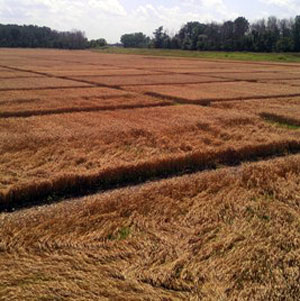Using Palisade plant growth regulator to improve wheat performance
For the first time in many years, wheat growers have a plant growth regulator available to help reduce the risk of plant lodging. Field testing of the product has led to some suggestions for growers who elect to try it on their farm.
 Plant lodging can be very detrimental to the quality and yield of wheat grain. During the spring of 2012, a plant growth regulator, Palisade, was registered for use in the United States by Syngenta Crop Protection Inc. The product curtails the plant’s ability to produce a growth hormone resulting in thicker stems and shorter internodes.
Plant lodging can be very detrimental to the quality and yield of wheat grain. During the spring of 2012, a plant growth regulator, Palisade, was registered for use in the United States by Syngenta Crop Protection Inc. The product curtails the plant’s ability to produce a growth hormone resulting in thicker stems and shorter internodes.
Photo: Wheat lodging; note the untreated plots in the foreground.
According to the Palisade EC label, application rates may range from 12 to 14.4 ounces per acre and the timing for application is from growth stage 5 (fully-tillered) to growth stage 8 (flag leaf visible). In a two-year study by Michigan State University Extension that studied the effect of Palisade on soft winter wheat performance, the use of Palisade significantly reduced plant lodging by reducing plant height by 1 to 4 inches and, more importantly, increasing stem thickness. The product tended to improve yields in 2012, but was not beneficial or detrimental in 2013 despite severe lodging.
Based on the experience to date through field research and observations within commercial fields, MSU recommends the following for growers electing to try Palisade in 2014.
- Use as a risk management tool where there is a high yield potential, the variety is prone to lodging and an elevated fertilizer nitrogen rate was used.
- In most cases, use 12 to 13 ounces per acre and apply early in the application window (apply from full-tillering to second joint stage).
- Note the label statement, “Do not apply if crop is stressed by drought, disease or temperatures.”
- Leave a strip of untreated wheat in order to gage Palisade’s cost effectiveness (Palisade may cost $12 to $16 per acre, but growers should check with their retailers to verify actual cost).
- Note any differences in plant color, lodging, maturity or grain quality where the untreated check is adjacent to Palisade treated area.
More work is needed to gain a better sense of Palisade’s compatibility with nitrogen and various fungicide products (the product label only includes Tilt and Quilt). In addition, observations are needed to determine if varieties respond differently to Palisade use.



 Print
Print Email
Email




